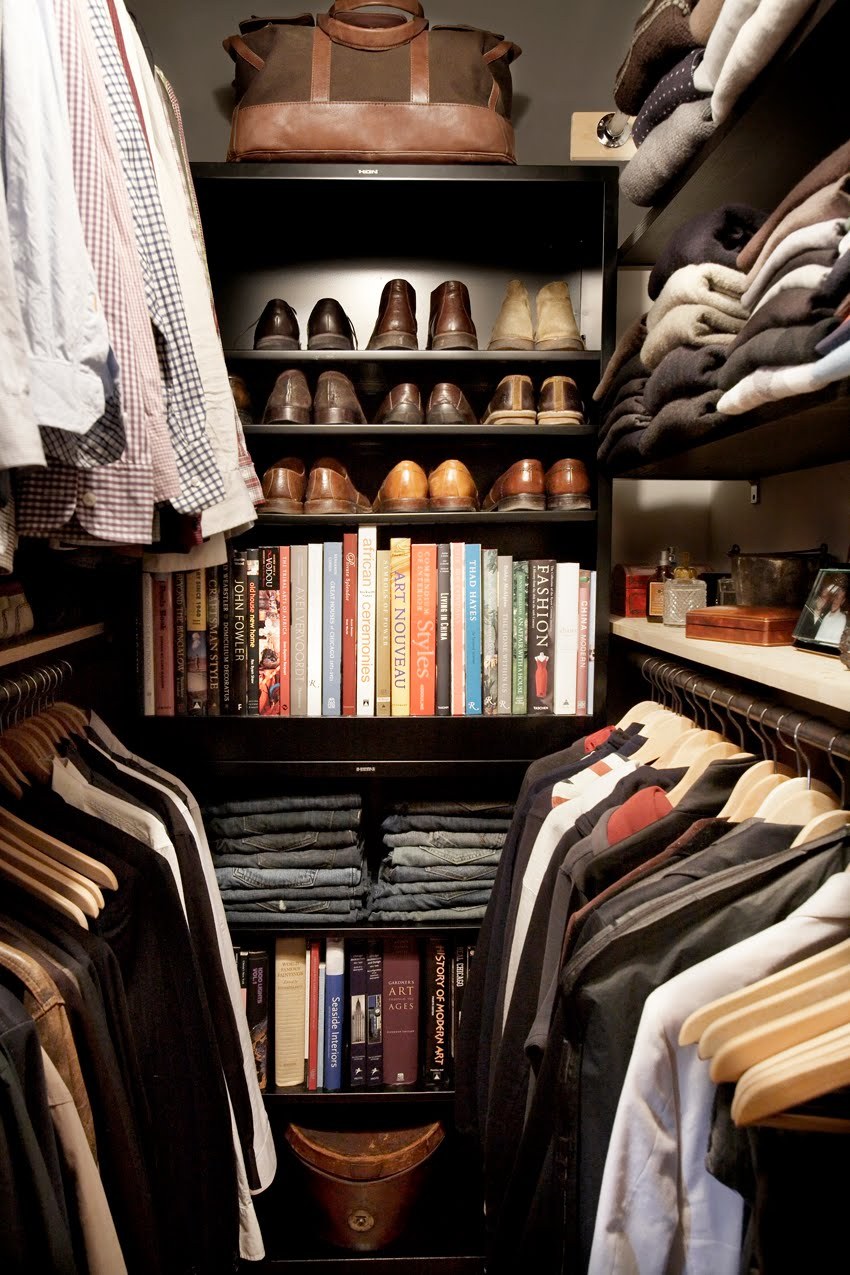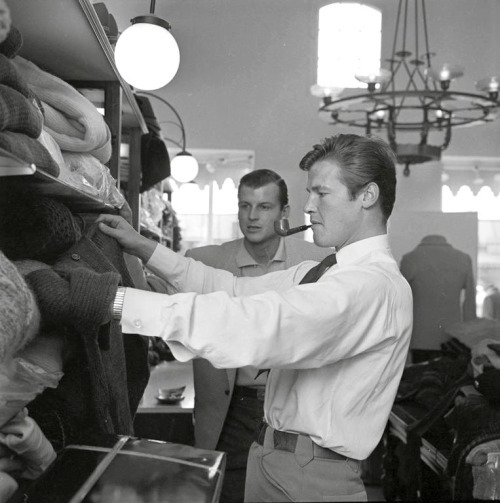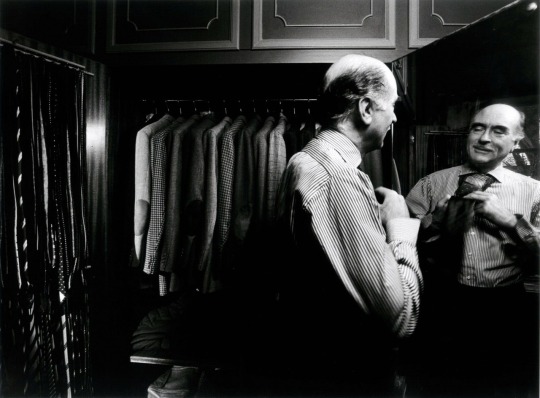
It’s crazy to think that Put This On is nearly ten years old, and while we have tons of posts aimed at people who are just starting to build a more intentional wardrobe, we’ve never written a guide on exactly how to get started.
To be sure, everyone has a wardrobe. We’ve all picked up that button-up shirt and pair of khaki chinos at the mall for a cousin’s graduation, then a dark suit for a buddy’s wedding. And there’s that pile of t-shirts slowly accumulated through different points in our lives — college days and various phases with bands. For most people, the process of building a wardrobe comes in fits and spurts, resulting in a mishmash of things that never feel quite right.
The idea of dressing intentionally means thinking though some basics of how you’d like to present yourself, then building a wardrobe around that. It’s a much more difficult and long process than some would like to admit. Online, you’ll find tons of guides on how to build a better wardrobe, but they’re often little more than shopping lists — a wardrobe of twenty business suits even though you may only need one, or a bunch of trendy “menswear essentials” that will be out of date by the time you buy them.
Dressing well takes a lot more than completing a shopping list. And for people who are just starting out, it can feel overwhelming — all the terms, fabrics, and styles (not to mention the prices!). So here’s a guide on how to get started, literally from day one when you want to transform your wardrobe.

LEARN THE BASICS OF FIT
The phrase “fit is king” is so well worn it’s become cliché, but it’s also popular for a reason. When you’re just starting to build a better wardrobe, the best thing you can do is pay closer attention to how your clothes fit.
The idea of fit is actually pretty nuanced and it’s closely tied in with something called silhouette, which roughly means the outline of your outfit once you take away all the details. And while it’s possible to be creative with how your clothes fit, for people who are just starting out, the concept is usually better when it’s more straightforward.
Ten years ago, the standard advice was to slim everything down — buy clothes a size, maybe even two, smaller. These days, however, you’re just as likely to see guys wearing clothes a size too small as those wearing a size too large. For now, focus on clothes that don’t veer towards either of these extremes. A moderate, middle-of-the-road fit — with good basics such as making sure a jacket’s collar hugs your neck — will give you a baseline off which to operate. Some things to look for:
- Broadly speaking, you want clothes that don’t pull, pucker, or bag. If you see lines across your chest or waist, or excess fabric creating folds where there shouldn’t be any, your clothes don’t fit. This is, of course, taking into account that fabric is lightweight and naturally moves. Be realistic, but make sure your clothes hang well.
- The point of clothes should be to flatter the shape of your body, not recreate it. Try different sizes and be honest with how something looks. Just because you’ve sized down on something doesn’t mean your body is actually slimmer. Tight clothes can make you look heavier than you are.
- Clothes need to fit well not just when you’re standing still, but when you’re moving around. Shirts shouldn’t be so tight that the midsection pulls when you sit; jackets can’t be so slim that you can’t comfortably move your arms. At the same time, be careful with clothes that are so baggy that they lack shape.
- Mostly, this is about constantly paying attention to things. When you see an outfit you like, notice where the seams fall, how the fabric hangs, and where things terminate.
Here’s the hard truth: it takes years to train your eye. This is much more of an art than a science. That said, when you’re starting to build a wardrobe — more than looking at “the right brand names” or thinking about quality — the best and most impactful way you can improve your wardrobe is by thinking of fit. Before buying anything, ask yourself: “Does this fit well? Does it flatter my body?”
We have a deep archive on the subject of fit, but here are some highlights:
- How certain clothes should fit: suits jackets and sport coats, tailored trousers, and dress shirts. These articles can be helpful even if you don’t plan to wear tailored clothing.
- The concept of buttoning points, collar gaps, and trouser breaks
- How long should a tailored jacket be?
- Where should trousers sit?
- A practical checklist when purchasing tailored clothes (and a similar guide from Japan)
- How to know when your shoes fit (tip: start by getting measured on the Brannock)
- How to think about silhouette in tailored clothing. This is a bit more advanced — think of fit as the basics of whether something sits on your body well; then silhouette as the shape of the outfit.

TAKE INVENTORY — CULL, KEEP, AND ALTER
This part is the least fun. Before you go shopping, take inventory of what you already have in your wardrobe. Then decide what to cull, what to keep, and what you can alter. Taking inventory not only allows you to clear out your wardrobe, decluttering the mess in the back of your closet, but it also allows you to take the next step — making a plan.
Cull things you know you’ll never wear. Maybe they’re in too shabby of a condition, they’re out of date, or they were never good in the first place. These clothes can either be sold online if you think you can get some money for them. Or they can be donated. We have a guide on how to get rid of old clothes.
Of the things you’d like to keep, try them on and assess how they fit. Revisit our guides linked in the previous section. Many issues can be resolved with a quick trip to a tailor (trust us, they do magic). Baggy shirts can be trimmed by taking in the sides or adding what are known as darts. Overly long trousers can be hemmed; overly straight trousers can be tapered from the knee down. Coats with engulfing sleeves can be adjusted; shapeless jackets can be nipped in the waist.
The quick and dirty rule when it comes to alterations: jackets and shirts should always fit well around the shoulders and chest; trousers ought to fit well around the seat and thighs. Almost anything else can be altered.
Bringing your favorite clothes to the tailor is the quickest an easiest way to improve your current wardrobe. It’ll cost money, but it’ll be less than what you’d spend to replace the items.
Some relevant posts to help you through this process:
- How to Get Rid of Old Clothes
- How to Find a Tailor
- How Much Can My Clothes be Altered?
- How Much You Can Expect Alterations to Cost
- What to Do When Something Fits Too Slim
- What are Darts?

MAKE A PLAN
So, now that you’ve done the two steps above, it’s time to make a plan. How do you build a new wardrobe? A lot of this takes honest self-reflection.
When you’re just starting out, it can be easy to get swept up into trends or buying clothes that don’t really fit your lifestyle. Maybe the hottest thing at the moment is furry Gucci slip-ons or Italian flannel cargo pants. Or you step into this thinking that you really need a wardrobe of twenty custom suits, even though you’ve gone your whole life never wearing suits at all. Think hard about what’s actually right for your life at the moment.
You can do this by answering some basic questions. Thinking through these will help you design a wardrobe that’s actually right for you:
- What do you like about your current wardrobe? What do you not like?
- What about your current wardrobe would you like to change? The colors, fit, quality, or styles?
- What from your current wardrobe do you find you wear the most? What do you wear the least? By sheer evidence of what you actually wear, you can get a more grounded sense of what’s actually right for your lifestyle. If it’s suits and sport coats, expand into that. If it’s rugged casualwear, try that for starters.
- What’s a realistic budget for you? Note, for many people just starting out, you’ll want to adjust your sense of how much good clothes cost. You don’t need to spend your life savings, but there’s a bare minimum for some things — $500 for a suit, $200 for dress shoes, etc.
- What would you like a new wardrobe to do for you? Allow you to express yourself through clothes? Help you in your professional life? Make you simply feel better? Explore your sense of identity?
Unfortunately, there’s no easy cut-and-paste plan that works for everyone. And it can take years before you finally settle on a wardrobe. There will be some money wasted; there will be outfits you regret. A lot of this is about trial and error.
That said, there’s some good, general advice that’s useful for beginners. This isn’t to say these are universal laws — this isn’t a science — but a way to build a platform. A platform that allows you to explore different styles while also looking good throughout the process.
- Start by simplifying. Avoid clothes with logos, prints, and crazy details. Instead focus on great basics (by which, we mean basics). A white t-shirt. Light blue dress shirts. White oxford button-ups. Blue jeans. Grey wool trousers. Khaki chinos. A dark suit. Great boots. Basic shoes. Again, this isn’t to say this is the wardrobe you’ll wind up in five years, but rather, they’re solid basics that give you a baseline from which to work.
- Build a wardrobe, not a set of outfits. Make sure new purchases work with the rest of your wardrobe — shirts that can be worn with different types of pants; pants that work with different types of jackets. One of the easier ways to do this is by narrowing your color palette. Blues, grays, browns, whites, and tans will all seamlessly work with each other, allowing you to pull things from your closet every morning without putting in too much thought.
- Buy less, buy better. In today’s throwaway culture, almost anything can be had for just a few dollars. Avoid impulsive purchases and shoddily-made things sold at fast fashion stores, such as H&M and Zara. Instead, buy fewer things, but buy better things. You’ll be happier in end. Carl Richards has a nice post about this at The New York Times.
- Buy mid-tier items. That said, when you’re just starting out, it’s good to focus on mid-tier items that won’t break the bank. Again, your taste will change rapidly over the next five years, so things will eventually get replaced. Don’t worry about buying “the best” for now. Think about using solid, mid-quality purchases, carefully considered and researched, as a way to experiment.
- Manage your budget. There’s no way around it, good clothes are expensive. Focus your budget on things that will make the biggest impact — outerwear and shoes, mostly, then perhaps knitwear. We also have guides on how to thrift locally and online, and some things are just better when they’re bought second-hand. Jesse’s post about “good, fast, cheap — pick two” is also a good read. And while buying on sale is always a good idea, it’s never good to buy something just because it’s on sale. Beware of sales psychology.
- Think about the message. One of the more common mistakes people make is thinking that an outfit is just a mishmash of shapes and colors — like a painting that comes together in a pleasing way. Often, dressing well is more akin to writing — even if, at times, creative writing. A dark suit with a white shirt and dark tie, sometimes accompanied by a white pocket square, sends a very specific message in a way that changing just one element would not. Similarly, raw denim jeans and a workwear jacket send another kind of message. Think about the message you’re creating.
- Build slowly. Don’t rush this. Be practical about what works for your lifestyle, what direction you’d like your wardrobe to take, and how you can build certain looks. Learning how to dress well typically starts by figuring out who or what inspires you. Take inspiration from art and culture — music, films, or historical subcultures. Save photos of outfits you like. StyleForum and Reddit’s Male Fashion Advice are great resources. We’d like to think our blog is useful too.
We’ll have more posts in the future on how to start building an intentional wardrobe, but here are some things in our archive that are worth reading:
- Shop Like Jesse’s Mom
- Check Out the Best
- Have a Plan
- How to Think About Color
- Know When to Splurge and When to Scrimp
- Scrimp, Save, and Shop Slowly
- If I Could Speak to My Younger Self